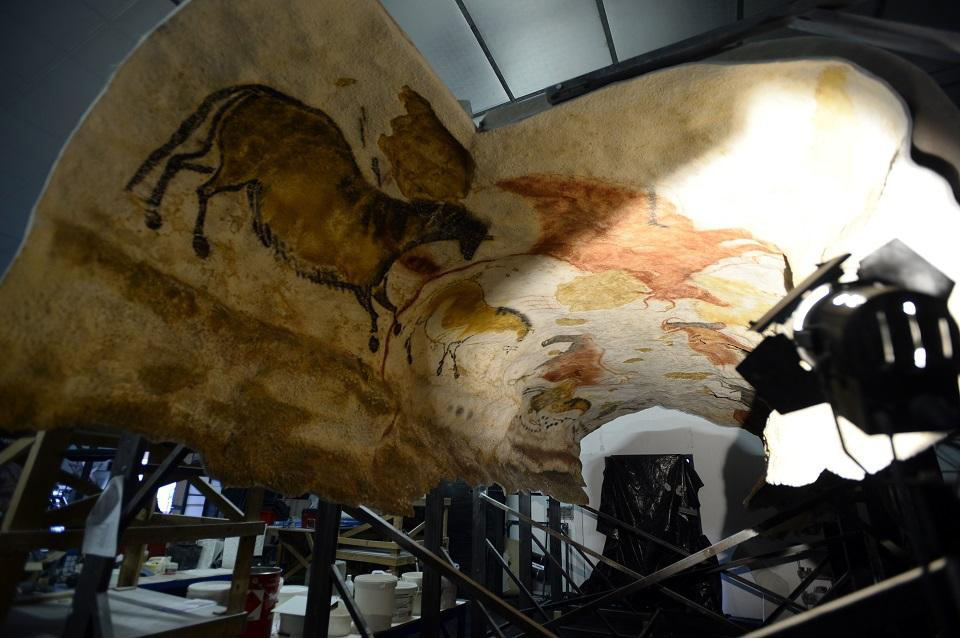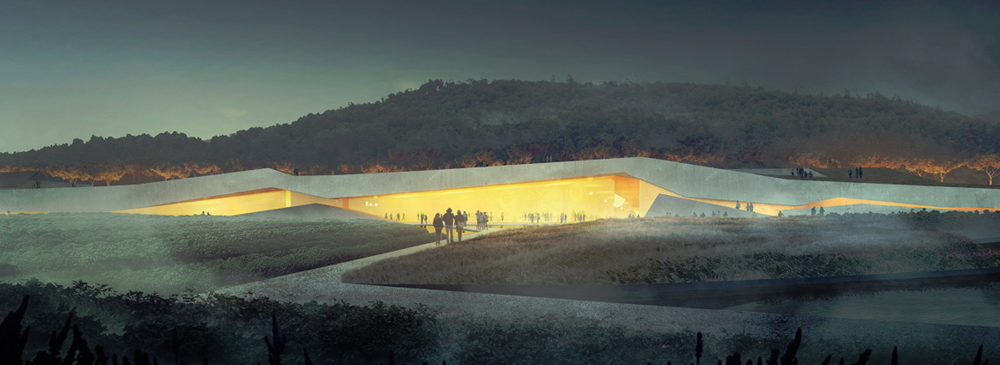


An online article by Laurent Banguet, Agence France-Presse and GMANews - French artists finish replica of 'magical' cave paintings - reports from Montignac on the army of artisans who have laid down their paintbrushes, chisels and pigments after three years of painstaking work to create a true-to-life replica of the renowned Stone Age cave paintings long hidden away in south-western France.

A picture taken on January 13, 2016 shows the facsimile of a rock painting stored at the future international cave arts museum, Lascaux IV, at Montigny-Lascaux. The first full replica of the Lascaux cave will be installed at the International Center of Parietal Art of Montignac, an 8,500-square-meter building designed to bring a new scientific, artistic and touristic dimension to the prehistoric find. Image: AFP PHOTO/Jean-Pierre Muller
"Absolutely all the work you see on the wall has been engraved, worked and sculpted, chiselled by hand, with little paintbrushes and sometimes even tools used in dentistry," said Francis Ringenbach, the artistic director of the project to replicate the 18,000-year-old Lascaux cave paintings.
The meticulously faithful copy of what has been dubbed the 'Sistine Chapel of prehistoric art' is now ready to be transported one segment at a time - 46 all together - and installed just down the road from the original at a site semi-buried in a hillside in Montignac, in the Dordogne region.

Artist's impression
The International Center of Parietal Art, 150 meters long and nine meters high, designed by Norwegian architectural firm Snohetta, will open by the end of the year.
The nearly 2,000 Upper Paleolithic wall paintings depicting rhinos, horses, bison, deer and panthers make up Europe's most important collection of prehistoric art and were inscribed on UNESCO's World Heritage list in 1979.
The caves, discovered in 1940 by four teenagers, quickly became a massive tourist draw, with around a million people flocking to see the work of the oldest known modern humans, who came to Europe from Africa via Asia.
Authorities closed them to the public in 1963 out of concern over the danger posed by humans to the delicate micro-climate.
The 57 million Euro project to replicate the entire set has married cutting-edge technology with a desire for the utmost authenticity in the reproduction.
The artists benefitted from 3D digital scans of the original paintings that were projected onto the walls, creating a task akin to using tracing paper as they applied layer upon layer of natural pigments.
Chief painter Gilles Lafleur said of the original works: "We try to understand them really, to understand how and why they were painted this way." But he admits that "time has taken its toll and these animals don't look the way they would have when they were painted. Time has had a visible impact, so we must also recreate that."
Ringenbach says he doffs his cap to the talent of our ancient forebears who only had rudimentary tools to create their masterpieces.
"They were extraordinary technicians, reproducing animal likenesses from memory with their highly vivid movements," he marvels. Reproducing the originals is, he says, a "magical" feeling.
Whereas the smaller-scale original museum could give only "limited insight" into the site's significance, "here, we reach a whole new level in terms of helping people to understand what Lascaux represents for science, the history of art, prehistory."
Visit the Lascaux section in the France Rock Art Archive:
http://www.bradshawfoundation.com/lascaux/index.php
Read about 'The Many Metamorphoses of Lascaux' by Pedro Lima in our Book Review:
http://www.bradshawfoundation.com/books/lascaux.php
The International Center of Parietal Art will open in the Autumn this year:
http://www.projet-lascaux.com/en
by Bradshaw Foundation
Monday 30 May 2022
by Bradshaw Foundation
Wednesday 19 January 2022
by Bradshaw Foundation
Thursday 06 January 2022
by Bradshaw Foundation
Monday 06 December 2021
by Bradshaw Foundation
Monday 29 November 2021
by Bradshaw Foundation
Monday 25 October 2021
by Bradshaw Foundation
Monday 12 July 2021
by Bradshaw Foundation
Monday 24 May 2021
by Bradshaw Foundation
Tuesday 20 April 2021
by Bradshaw Foundation
Thursday 01 April 2021
by Bradshaw Foundation
Tuesday 23 February 2021
by Bradshaw Foundation
Thursday 14 January 2021
by Bradshaw Foundation
Friday 18 December 2020
by Bradshaw Foundation
Sunday 06 December 2020
by Bradshaw Foundation
Thursday 26 November 2020
by Bradshaw Foundation
Wednesday 07 October 2020
by Bradshaw Foundation
Monday 30 May 2022
by Bradshaw Foundation
Wednesday 19 January 2022
by Bradshaw Foundation
Thursday 06 January 2022
by Bradshaw Foundation
Monday 06 December 2021
by Bradshaw Foundation
Monday 29 November 2021
by Bradshaw Foundation
Monday 25 October 2021
by Bradshaw Foundation
Monday 12 July 2021
by Bradshaw Foundation
Monday 24 May 2021
by Bradshaw Foundation
Tuesday 20 April 2021
by Bradshaw Foundation
Thursday 01 April 2021
by Bradshaw Foundation
Tuesday 23 February 2021
by Bradshaw Foundation
Thursday 14 January 2021
by Bradshaw Foundation
Friday 18 December 2020
by Bradshaw Foundation
Sunday 06 December 2020
by Bradshaw Foundation
Thursday 26 November 2020
by Bradshaw Foundation
Wednesday 07 October 2020
Friend of the Foundation











